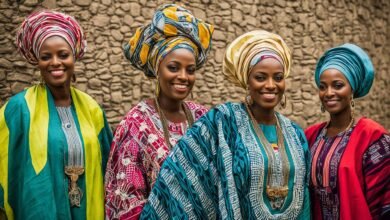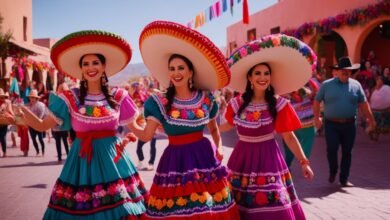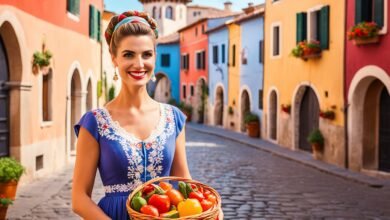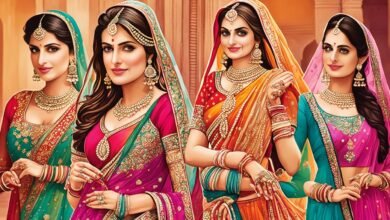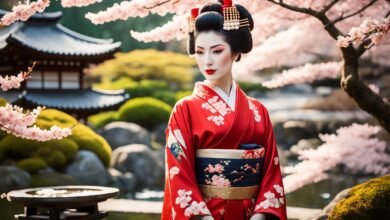Imagine standing in the middle of Colombia. Everywhere you look, there are bright colors and lively music. This scene captures the essence of Colombia’s cultural heart. And the traditional clothes reflect this rich heritage.
Colombia’s traditional clothes tell stories. They show where the various designs and styles come from. You’ll see influences from indigenous people, Spanish settlers, and the African community. Wearing these clothes celebrates Colombia’s history while embracing today.
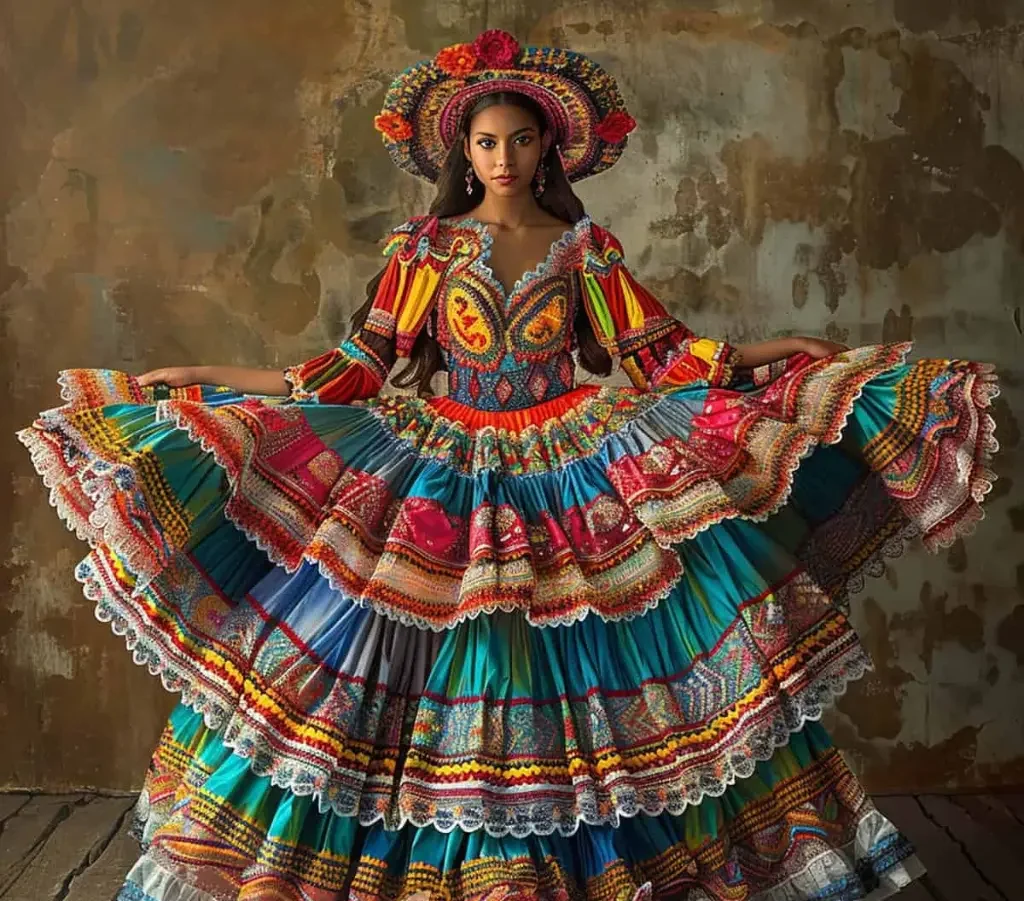
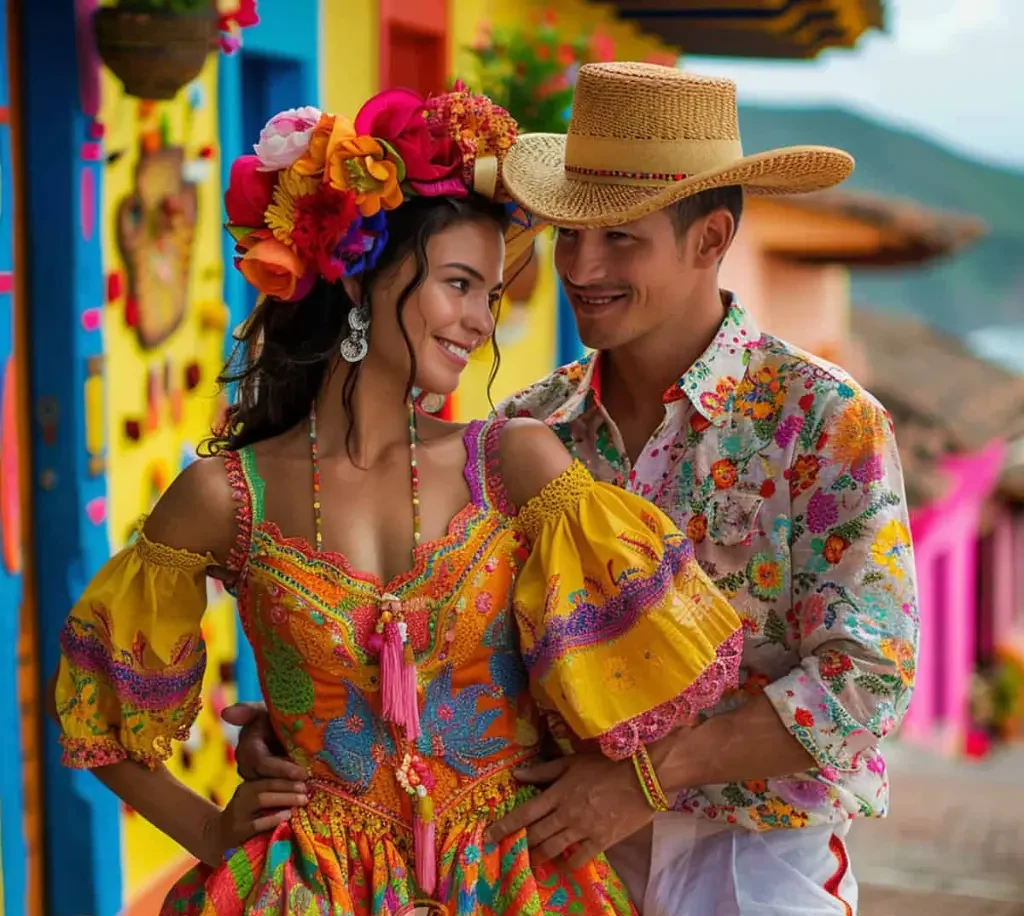
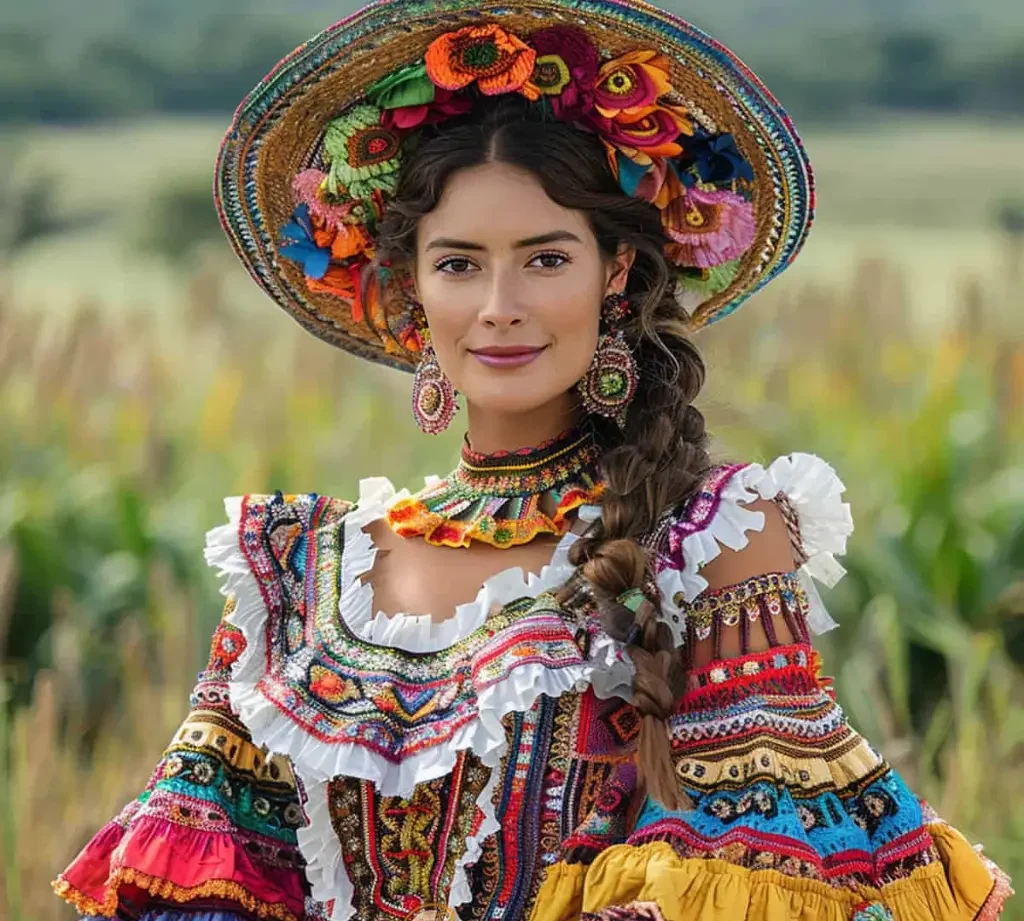
Let’s explore Colombian traditional clothing together. You’ll dive into a world filled with vibrant colors and unique designs. Each piece tells a story. And by wearing them, you honor a cultural tapestry that’s rich in heritage.
This journey will deepen your understanding of the clothes’ craftsmanship and the pride they carry. We invite you to discover the beauty of Colombian traditional wear with us. Let it inspire you and draw you closer to Colombia’s cultural essence.
Traditional Clothing in the Andean Region of Colombia
The Andean region of Colombia is known for its beautiful traditional clothes. These clothes, called Colombian folk clothing, are very important to the area’s culture. They are worn at special events and dances. The bright colors and detailed designs show the Andean people’s rich heritage.
The traditional dress of Huila is famous in the Andean region. It’s worn during the San Juan festival for the Sanjuanero dance. Women wear a white shirt and a colorful skirt with flowers in the hair. Men wear white shirts, trousers, a red scarf, a leather belt, and a hat. Their clothes show local style and cultural pride.
The Andean clothing shows the skill and hard work of local artists. These clothes are made with the best materials like cotton and silk. They are known for their beautiful embroidery and use of traditional patterns. This makes each outfit special and unique.
The Colombian folk clothing is more than just clothes. It’s a treasure of the people’s culture and history. By wearing these clothes, the Andean population remembers their past and values. It’s a way of showing pride and keeping their traditions alive for future generations.
Take a closer look at the exquisite Andean traditional clothing in the image below:
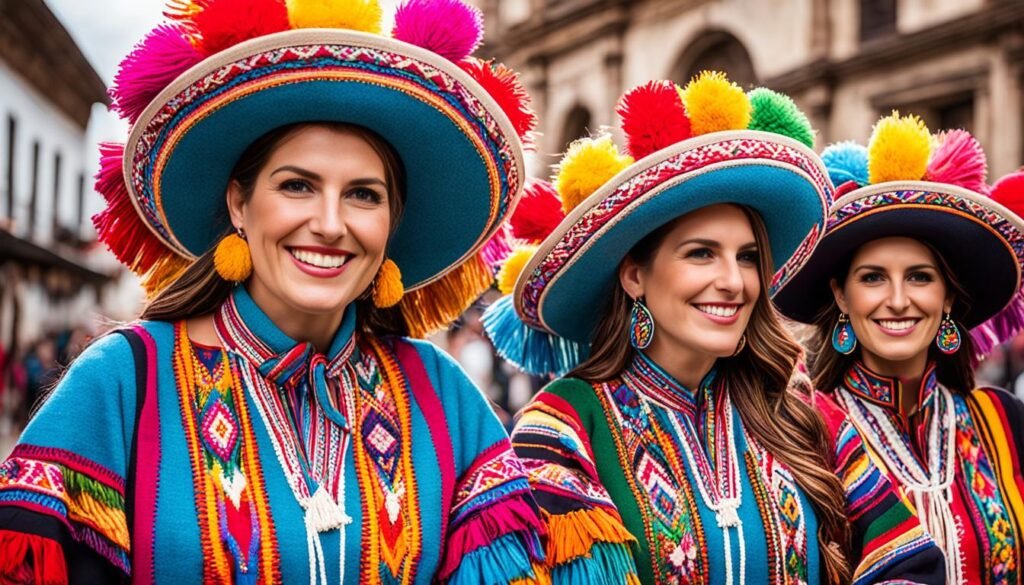
Traditional Clothing in the Orinoco Region of Colombia
The Orinoco region in Colombia is famous for its warm plains. Here, you’ll find traditional clothing that’s easy to wear. Its bright cultural heritage shines through in the clothes worn at celebrations and dances.
When people dance the Joropo, women wear big skirts. These skirts are usually red or white and decorated with ribbons and flowers. Men choose a stylish look with white pants and a black or red shirt.
There are even more styles in the Orinoco region. You might see men in colorful shirts with linen pants. Some men go for an all-white look. This variety shows off the area’s energetic culture and creativity.
The Wayuu people, from La Guajira, have their own unique clothes. Their traditional dress includes loose dresses with woolen tassels and special Wayuu bags. These outfits are both beautiful and a source of pride for the Wayuu community.
Local textiles are also a big deal in the Orinoco region’s fashion scene. They show off bright colors and detailed techniques. This highlights the community’s love for craft and their own resources. These traditional textiles are a key part of the region’s cultural story, showing its deep history and diverse people.
“The traditional clothing of the Orinoco region combines simplicity and vibrancy, allowing the wearer to embody the spirit of celebration and cultural pride.” – Fashion Historian
Traditional Clothing in the Orinoco Region
| Garment | Women | Men |
|---|---|---|
| Joropo dance attire | Wide skirt with a red or white background, decorated with ribbons and flowers | White pants, black or red shirt |
| Alternative attire | Bright-colored shirts with linen pants or all-white attire | Bright-colored shirts with linen pants or all-white attire |
| Wayuu traditional dress | Loose dresses with woolen tassels and vibrant Wayuu bags | N/A |
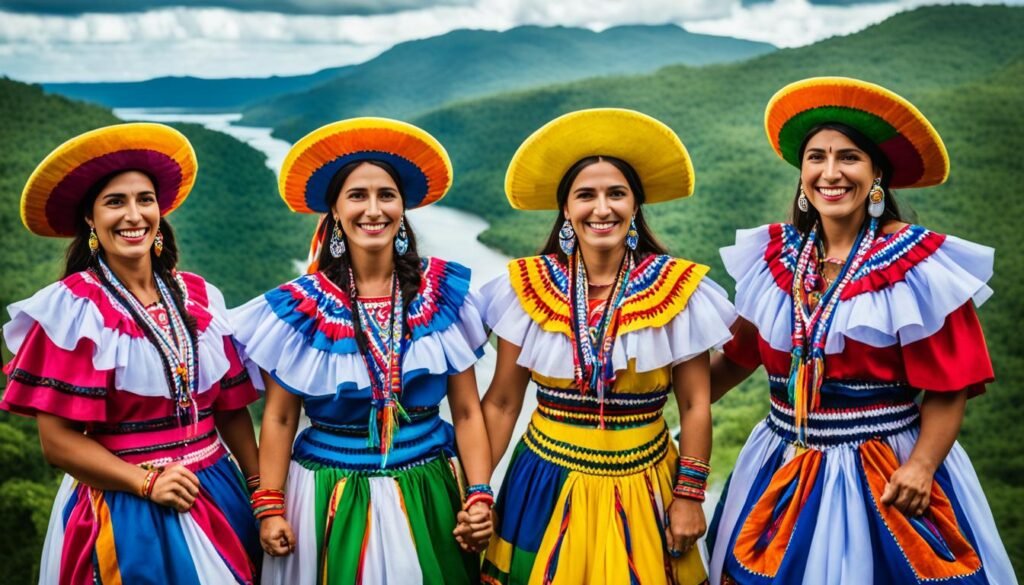
The traditional clothes from the Orinoco region in Colombia celebrate their rich culture. With vibrant colors and unique designs, these outfits reflect the area’s heritage and diversity. This clothing is a nod to the local communities’ strong cultural pride and spirit of celebration.
Traditional Clothing in the Caribbean Region of Colombia
The coastal Caribbean region of Colombia is known for its colorful and light traditional clothing. This clothing keeps wearers cool in the hot and humid weather. Men and women both wear outfits that are very breezy and lively.
Men wear bright shirts with comfortable linen pants for a cool look. These outfits are perfect for the warm climate because of the light fabrics. They can enjoy the weather and keep their style.
Women choose loose skirts and tops for easy movement and to stay cool. These clothes are also made of lightweight materials. So, they show the region’s rich culture while feeling comfortable.
The “vueltiao” hat is a key piece of clothing from this area. It’s made of dried cane leaves and is vital in Colombian culture. Both men and women wear it, showing its importance.
The Wayuu people, who live in La Guajira, have their own special clothing. Women wear brightly colored, loose dresses. They match them with unique sandals and carry handmade bags. This expresses the beauty and creativity of their community.
 Embrace Elegance with Traditional Clothing in Italy
Embrace Elegance with Traditional Clothing in Italy
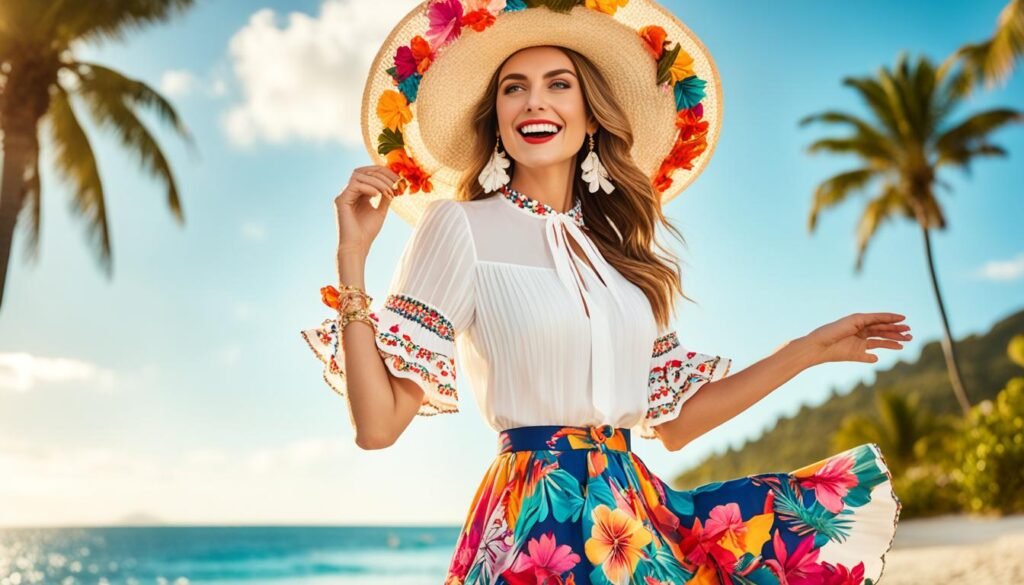
| Traditional Elements | Men’s Attire | Women’s Attire |
|---|---|---|
| Bright Colors | Bright-colored shirts | Flowy skirts and tops |
| Lightweight Fabrics | Linen pants | Lightweight skirts and tops |
| “Vueltiao” Hat | Worn by both men and women | Not applicable |
| Wayuu Traditional Dress | Loose dresses, sandals with woolen tassels | Loose dresses, sandals with woolen tassels, colorful Wayuu bags |
Traditional clothing from the Caribbean is a unique mix of colors, fabrics, and accessories. The “vueltiao” hat and the Wayuu dress are just some examples. They show the country’s diverse and rich cultural heritage.
Traditional Clothing in the Amazon Region of Colombia
The Amazon region in Colombia is special because of its many indigenous cultures. Each group has its own way of dressing, showing their unique traditions and values. Their clothes are not just clothing. They are a symbol of who they are and their history.
Women in the Amazon wear skirts that go down to their calves. These skirts are full of life with bright colors and patterns. The women also wear white tops, which mean they value being pure and spiritual. To complete their look, they add belts and necklaces. These are not just any accessories. They come from nature and are important parts of their culture.
Men also have special clothes that are meaningful. They wear white pants or skirts. This choice of color is intentional. It symbolizes their unity with their environment. Their outfits are not complete without natural necklaces. This shows their respect for nature and what their ancestors taught them.
These garments mean a lot more than just looking good. They show how strong and lasting the indigenous peoples are. By wearing these traditional clothes, these groups keep their heritage alive. This is a way for them to ensure their special culture is remembered and valued.
“The traditional clothing of the indigenous communities in the Amazon region of Colombia is a testament to their rich cultural history and their deep connection to their surroundings. These garments showcase the diversity and vibrancy of their traditions, and wearing them is a way to honor their ancestors and preserve their unique identity.”
The Traditional Dress of the Siona People
The Siona people are an important group with their own unique style. They wear calf-length skirts, showing off bright patterns and colors. These designs are not random. They are tied to nature and have spiritual meanings. Women also have special shawls and wear feathers in their hair. This is all about their deep respect for the world around them.
The Siona traditional clothes are more than just outfits. They are a direct link to the rainforest. Wearing these clothes means remembering where they come from. It’s a way to show the world that protecting their culture and the environment is very important to them.

| Traditional Garments | Symbolism |
|---|---|
| Calf-length skirts | Represent the vibrant biodiversity of the rainforest |
| White blouses | Symbolize purity and spirituality |
| Indigenous belts and necklaces | Showcase authenticity and cultural heritage |
Traditional Clothing in the Pacific Region of Colombia
The Pacific region in Colombia is known for its lively, traditional clothes. These clothes show the area’s warm climate and African roots. You’ll see outfits full of color and soft pastels, decorated with flowers and ribbons.
In this part of Colombia, women wear long skirts that reach their ankles. These skirts come in bright colors like pink, blue, or yellow. The skirts are light and soft, perfect for dancing and moving in the heat.
Men’s style here includes loose shirts and tunics with vivid patterns. This airy clothing keeps them cool in the warm, moist air. For special occasions, men wear colorful wraps and accessories. This shows how African culture is part of their dress style.
The African influence is clear in the bright colors and bold patterns of these clothes. Flowers, ribbons, and other decorations make the outfits look even more festive.
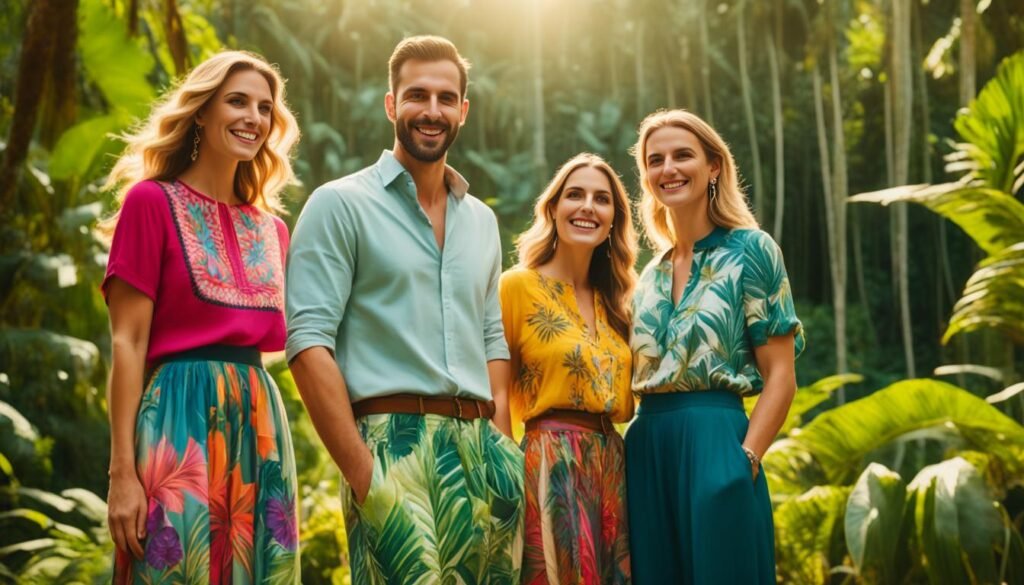
| Features | Description |
|---|---|
| Colors | Vibrant shades of pink, blue, yellow, and more |
| Skirts | Ankle-length skirts made with soft and lightweight fabrics |
| Men’s Attire | Loose-fitting shirts or tunics in bright prints and patterns |
| Decorative Elements | Flowers, ribbons, and other adornments |
History of Traditional Clothing in Colombia
The history of traditional clothing in Colombia is a mix of many cultures. It shows off the beauty of the country’s various groups. These groups make their own clothes, which are more than fabric. They are symbols of pride and who these people are.
Colombians love using natural fabrics like cotton and wool for their clothes. This shows how much they value their environment. The clothes are colorful and full of detail. They tell stories of Colombia’s unique culture, from the Andean slopes to the warm Caribbean.
In the Andean region, special clothes are worn for celebrations and dances. Places like Huila have dresses with ruffles and flowers. Men’s outfits are just as special, with a white shirt, trousers, and a handmade hat.
The Orinoco area’s clothing is influenced by indigenous ways. People wear special outfits for dances. Women wear big skirts, and men wear colorful shirts. The Wayuu group from La Guajira stands out with their colorful dresses and bags.
The Caribbean coast has clothes that keep people cool. Women wear light skirts and tops, while men prefer colorful shirts. The famous “vueltiao” hat is from here. It’s a must-have and a symbol of Colombian identity.
In the Amazon, clothes reflect the indigenous groups’ culture. Women wear skirts and blouses with special accessories. Men’s wear is also traditional and colorful. This clothing ties them closely to nature and their rituals.
The Pacific region’s clothes are light and often have African influences. They use soft colors and fabrics. Women’s skirts go to the ankles, and men wear loose, colorful clothes. These African touches are seen in events and dances.
“Traditional clothing in Colombia is a gateway to understanding the country’s diverse heritage. Each region has its own style and traditions, but they all share the common thread of celebrating cultural richness.”
The tale of Colombian traditional clothing shows the nation’s rich culture. From the mountains to the coast, each area’s clothes are unique. These garments are more than just outfits. They are history and show the beauty of Colombia’s people.
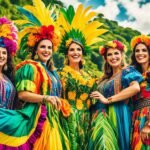 Discover Traditional Clothing in Brazil Today!
Discover Traditional Clothing in Brazil Today!
Discover more about the traditional clothing of Colombia in the following table:
| Region | Distinctive Features |
|---|---|
| Andean | Ruffled blouses, satin skirts, hand-made hats |
| Orinoco | Wide skirts, ribbons, flowers, Wayuu bags |
| Caribbean | Flowy skirts, bright-colored shirts, “vueltiao” hats |
| Amazon | Calf-length skirts, white blouses, indigenous belts |
| Pacific | Pastel colors, soft fabrics, floral decorations |
Immerse yourself in the vibrant world of Colombian traditional clothing and experience the beauty of its cultural heritage. From the intricate designs to the bold colors, Colombian ethnic clothing represents a rich tapestry of history, customs, and national pride
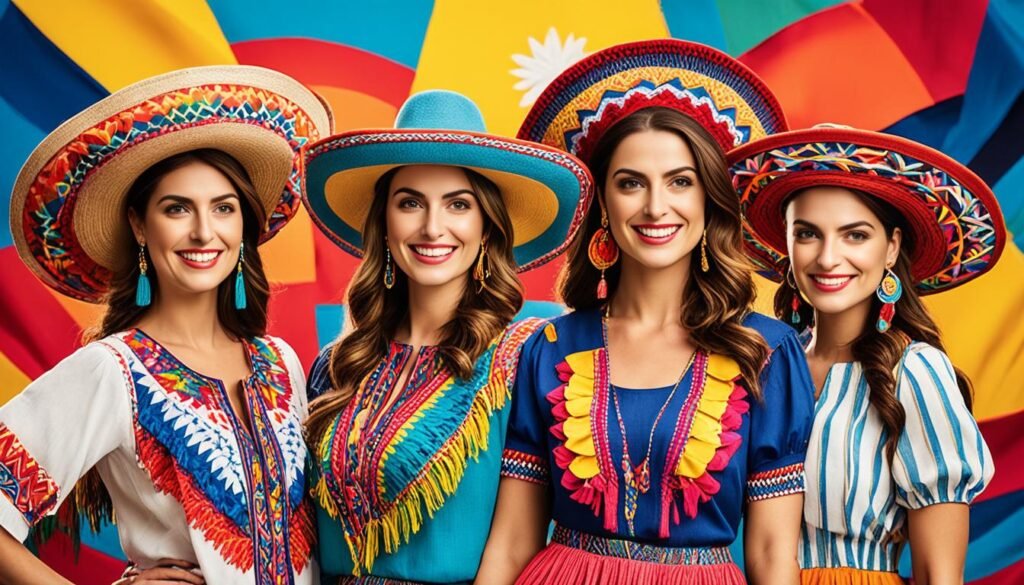
Colombian Traditional Garments and Accessories
Colombian traditional clothes and items are more than style. They share the country’s rich culture. These show customs and art passed from one Colombian to another. They show the beauty and mix of Colombia’s cultural wear.
In the Andean region, men wear ponchos for warmth. Women wear ruffled blouses and colorful skirts for events. They show off in bright colors and detailed patterns, highlighting Colombian culture.
The Caribbean has the famous “vueltiao” hat. It’s made from cane leaves and signifies Colombia. Alongside, traditional accessories complete any outfit. These include woven sandals and beaded necklaces.
To grasp the beauty of Colombian clothing, see it during festivals. These events showcase the pride in Colombian culture through clothes. Each region’s dance has unique outfits. This makes the experience very special.
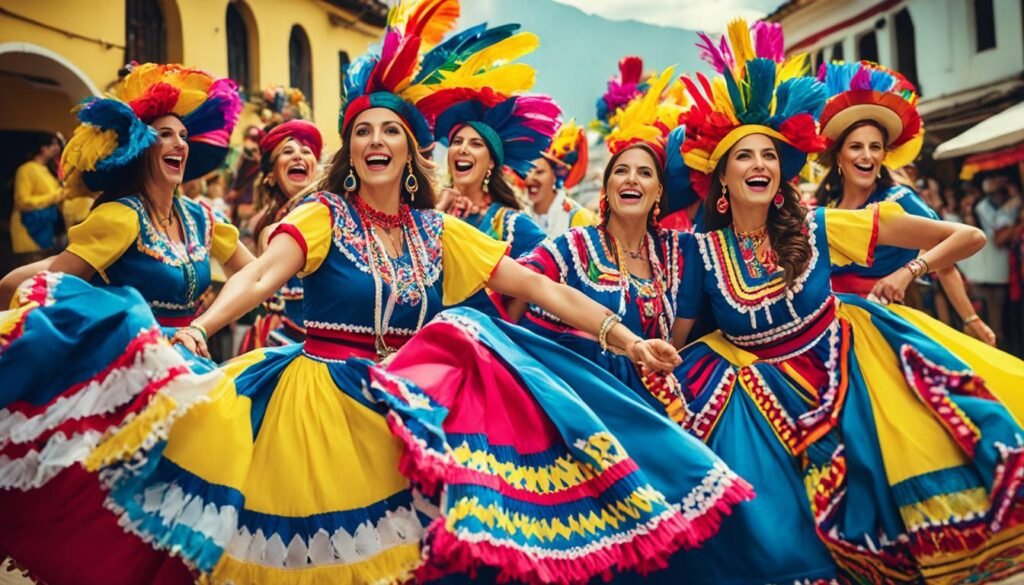
Traditional Colombian wear is more than fashion. It shares deep meaning and pride. These clothes show the country’s history and diverse traditions. Wearing them honors ancestors and keeps culture alive.
Seeing Colombian clothing, appreciate the stories each piece tells. They embody Colombian culture. By valuing these traditions, we celebrate Colombia’s rich heritage.
Colombian Traditional Clothing as a Symbol of National Identity
Colombian traditional clothing represents more than just outfits. It stands for the country’s history and identity. Designs include influences from Spanish, indigenous, and African cultures. This shows Colombia’s rich cultural mix.
Wearing these clothes brings out cultural pride. It ties Colombians to their heritage and fellow citizens. The clothes highlight Colombia’s unique style and history.
“Traditional clothing in Colombia is a vibrant sign of our diverse culture and identity. Each region has a unique style, blending old traditions and our diverse background. When worn, these clothes carry our history, uniting us in our Colombian identity.”
Colombian garments visually portray the country’s culture. They feature detailed embroidery, bright colors, and fine craftsmanship. These show off the skill and creativity of Colombian makers. Each piece tells a story of passed-down traditions.
These clothes are vital for keeping and sharing Colombian culture. They reflect the people’s resilience and beauty. They remind us of Colombia’s rich cultural past.
The Significance of Colombian Traditional Clothing
Colombian traditional clothing is more than beautiful. It shows where someone comes from and their culture. It celebrates the country’s strong spirit and ability to keep traditions alive.
The intricate designs and colors in these clothes are well-loved globally. They have sparked interest in Colombia’s cultural heritage. This supports local artists and designers economically.
Wearing and keeping these clothes is a uniting force among Colombians. It links their past to the present, showing their deep cultural roots. It’s about who they are and where they come from.
Keeping traditional clothing alive is about celebrating diversity and Colombian pride. Through these clothes, Colombians honor their history. They inspire future generations to cherish their cultural heritage.
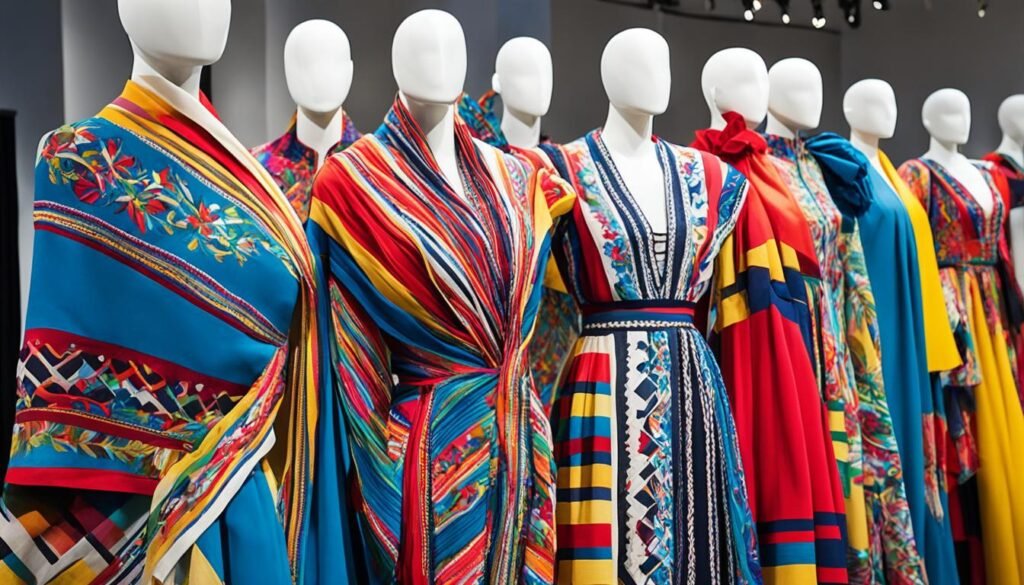
| Region | Description |
|---|---|
| Andean Region | This region showcases traditional Colombian garments such as the ruffled white blouse and colorful satin and lace skirt worn during the Sanjuanero dance. |
| Orinoco Region | Traditional clothing in this region includes wide skirts decorated with ribbons and flowers for women and white pants and shirts for men. |
| Caribbean Region | The coastal Caribbean region is known for its flowy skirts, bright-colored shirts, linen pants, and the iconic “vueltiao” hat made from dried cane leaves. |
| Amazon Region | Indigenous communities in the Amazon region wear minimal clothing, with women donning calf-length skirts and white blouses adorned with indigenous belts and necklaces. |
| Pacific Region | Traditional clothing in this region is influenced by the hot climate and African heritage, featuring colorful, pastel garments with floral and decorative elements. |
The Important Role of Traditional Clothing in Latin America
Traditional clothing is really important in Latin American culture, especially in Colombia. It helps people show off their heritage with pride. Each country has its own special traditional clothes, mixing native, Spanish, and African styles.
In Colombia, these clothes show how diverse the culture is. The cloth used is unique and full of bright colors and detailed designs. No matter if it’s the outfits from the Caribbean or the Andean areas, every piece has a special story to tell.
These clothes aren’t just for fancy events. They are also key parts of many celebrations and rituals in Latin America. They keep the old ways alive and show how strong traditions are. Wearing Colombian traditional clothing helps people feel close to their culture and roots. It’s a sign of the lively, rich cultures in the area.
Even as Latin America changes with time, traditional clothing remains special. It reminds us of the amazing history and culture of these lands. By wearing these clothes and valuing what they stand for, people help keep Latin America’s culture alive.
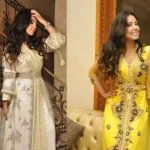 Embrace Elegance with Traditional Clothing in Morocco
Embrace Elegance with Traditional Clothing in Morocco
